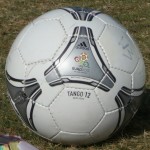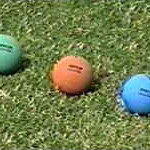A ball is a ball is a ball, right? We can’t get Gertrude Stein to confirm, so we asked one of our coaches. Here’s his take:
“I judge soccer balls by their covers and bladders.”
 Covers:
Covers:
Usually made out of polyurethane (PU/TPU) or poly vinyl chloride (PVC).
- PU/TPU covers are softer, but get scuffed more easily on pavement.
- PVC tends to be harder, but holds up well on pavement.
- You occasionally see leather balls, which are soft, but get heavy when wet.
Bladders:
Usually made out of latex or butyl.
- Latex: Softer, requires periodic pumping (typically once a week). Doesn’t go totally flat, just loses a bit of air.
- Butyl: Harder, tends to hold air longer (sometimes months on end).
I like the PU/TPU with latex combo (softer, good touch). I hate the PVC with butyl combo (the ball often feels like a rock), but would be willing to own one for pavement play. The PU/TPU with butyl combo works well for practice balls.
How to test for a rock:
Toss the ball into the air, bring your knee up, and let the ball strike your thigh muscle. Or toss the ball into the air, and take a touch using the laces of your foot before the ball hits the ground. If there’s any pain, you’ve found a rock. If you’re an adult, you can also try a header test, but we don’t recommend that for younger players, when heading the ball in practices and games is off-limits.
Other factors:
Size:
- We use a size 3 for the Junior Academy, and a size 4 at the U9-U12 Academy ages. Kids move to a size 5 when they get to under-13. (Size 5 is the standard size soccer ball for U13s and older, including high school, college and pro play.
Stitching:
- Most balls are still hand-stitched. Some of the expensive ones are thermally bonded. (Some really cheap balls are also thermally bonded, but their bonding process is lower quality than what you get with the expensive thermally bonded balls.) Stitching doesn’t make much of a difference in the ball’s “feel” to the player’s foot, but it affects the ball’s movement when in flight. For Academy-age players, thermal bonding isn’t worth the price difference over stitched balls.
Lining:
- When it comes to lining (material between the bladder and cover), the only thing that matters to me is “no thick foam!” Some manufacturers add foam padding under the cover. If it’s too thick, the ball tends to be sticky and causes young players to trip over it. Some balls’ padding doesn’t really make the ball any softer, just sticker.
Shopping:
Few if any manufacturers include all these details on their balls or packaging, but you can find most of this info on soccer.com. (Soccer.com is also known as Eurosport. They are our uniform supplier, and I’ve been a customer of theirs since the 1990s.)
Soccer.com links:
- Soccer ball buying guide: https://www.soccer.com/guide/soccer-ball-guide
- Soccer ball listings: https://www.soccer.com/shop/products/equipment/soccer-balls. Click on any of the balls for complete descriptions.
Want to buy locally?
If you want to shop locally, you can do so through the typical big box athletic stores, or via specialty soccer stores.
The quickest test is to do some foot and head juggling. If the ball feels like a rock, don’t buy it! If the ball isn’t pumped, ask the merchant to pump it for you so you can test it. Do a few headers from self-tossed serves, and if you’re not sure, have your daughter toss the ball to you with underhand serves for some headers (or toss them to her). If it hurts, don’t buy it!
Cost:
You can find a good quality ball for around $25. At this price point, Adidas and Select tend to make better balls than Nike. I don’t have much experience with the other manufacturers. $40 and up balls are usually better quality, but I don’t think they’re worth the price for young players who practice or play in areas where balls can easily get lost.
Here’s a link with even more info: www.soccerballworld.com. The site has some good info. I disagree with the author on a few points, but respect the level of detail he provides.
 Specialty balls:
Specialty balls:
Check this link for some special-purpose soccer balls.


